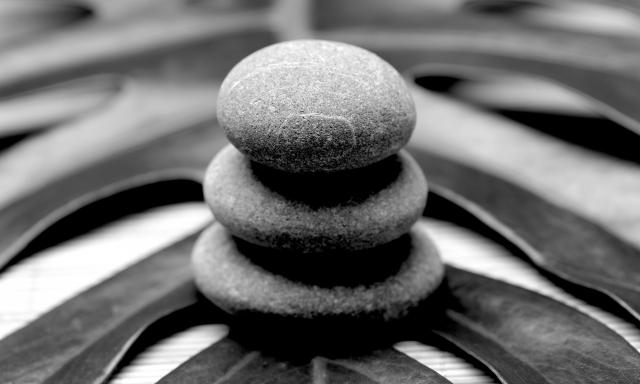

 Article
Article

 an businesses learn from Eastern philosophies? Major names like Disney, Dollar General and Men’s Health have implemented principles of Ki Aikido to great success. Professor Bourgeois discusses the concept of ki and the six lessons on energy and strategy one may glean from Kōichi Tōhei’s simple, profound “Principles of Mind and Body Unification.”
an businesses learn from Eastern philosophies? Major names like Disney, Dollar General and Men’s Health have implemented principles of Ki Aikido to great success. Professor Bourgeois discusses the concept of ki and the six lessons on energy and strategy one may glean from Kōichi Tōhei’s simple, profound “Principles of Mind and Body Unification.”

Insights from
Eastern philosophers teach us to stay balanced by following the Middle Way with perseverance and discipline. Such balance allows a firm to take appropriate strategic responses in challenging situations.
The concept of ki translates most simply as energy, or spirit. Ki Aikido is based in principles and ideas deriving from both the martial art of aikido and the Japanese system of yoga taught by Nakamura.
Kōichi Tōhei distilled his method into a set of six simple yet profound rules, which he termed “Principles of Mind and Body Unification.” Together, these principles constitute both a practical psychology of being in the world and a concise model for the realization of universal mind.
There are several ways to think about your one point. First, in a standing position, your one point is roughly equivalent to your physical center of gravity; however, it is foremost a point of mental concentration. As Tōhei discovered, focusing on the one point is the best way to calm the mind and relax the body.
In business, the one point could be the equivalent to your organization’s basic purpose. For example, Cal Turner Jr., CEO of Dollar General (DG), would proclaim DG’s mission as “to provide uncommon value to limited-income buyers of basic consumables” whenever he visited any of the 5,000 stores. Any new hire, any merchandise purchase, and any new store location had to stand up to the company’s basic values. Holding this one point allowed DG employees spread across rural America to behave according to its values with limited supervision or control systems.
We all carry around a certain degree of tightness and tension in our bodies. This tension can be a chronic consequence of our lifestyles or a situational response to circumstances. Whatever the origin, tension is always detrimental to our short-term ability to act and to our long-term health and well-being.
There are two main forms of relaxation, which can be termed nonactive and active. Nonactive relaxation is equivalent to going limp and serves no other functional purpose. Active relaxation, on the other hand, is always beneficial.
Active relaxation entails letting go of all the tightness and tension in the body, but not the active energy coursing through us. The experience of active relaxation is one of calm readiness. To relax completely, therefore, is to rid mind and body of all tension and create a state with the potential for experiencing and responding to any circumstance.
A way to think about corporate “relaxation” is to consider firms that are constantly reaffirming their values and rewarding those who live by them. In this case, relaxation does not imply laziness, lack of urgency or slowing the pace necessary to compete. Rather, it means eliminating the distractions to smooth operations and the stressors that inhibit flow and creativity. It even means eliminating anger, which is the recipe for both employee and customer turnover.
The grounding of weight underside is one of the critical factors that allow the practitioner of Ki Aikido to receive the energy of an attack by neither fighting the energy nor giving in to it. It also creates a solid foundation from which to move in any direction as needed.
The deepest sense of grounding is not equivalent to the notion of being rooted. The Ki Aikidoist standing with weight underside is not rooted to one spot but rather is more akin to floating. In effect, the practitioner floats on the surface of the ground as a boat floats on the surface of the water.
EdCon of Johannesburg, South Africa, was a mass retailer much in the style of Walmart. Its expansion through acquisition had a simple principle: Stay south of the equator. As Bayode Christiann, the head of strategy, told us, “We’ve built a solid foundation in south and middle Africa and understand both the logistical challenges of our vast geographic areas as well as the needs of our emerging-economy customers. The large northern retailers — Tesco, Carrefour, Walmart — are not interested in our markets. Yet. But when they look in this direction, we will be so ensconced and well-networked that we will be immovable.”
We are always extending our ki, whether we realize it or not. When someone enters a room, posture, movements, facial expression will have an immediate impact on those around them. The critical points are that we have control over what kind of ki we extend, and we have control over to what direction that ki is extended. We can send our energy in a single focused direction, or, as is most often relevant, in all directions simultaneously, like a sphere, with our one point being the center of that sphere from which our energy emanates.
In any situation, the central value of the spherical extension of our ki is that it completely engages us with our situation. In the midst of an attack, fear and anxiety tend to result in our pulling in our ki, dissociating ourselves from the situation. When this is the case, we cannot pick up or process the information required for adequately dealing with or resolving the situation. The full extension of our ki awareness, however, makes it possible to fully connect to our world and receive all the information needed to move forward.
Disney Development Corporation, Disney’s new business innovation unit, met to find new businesses within as-yet-unexploited capabilities. By the time the group broke, they had in hand the blueprint for the Disney Institute at Disney World, which expanded beyond all expectations to become what is now the Disney Animation School, a nationwide education program available to public schools and colleges. In other words, Disney “got bigger” and “took up more space” as it extended the ki from its animation one point.
Philosophy aside, our specific aim is to create the optimal conditions to take any action that might be called for. Full engagement means harmonization, and in this case harmonization means the full acceptance of the ki or energy of the situation. We extend our ki from our one point into the world, but then we must take the ki of the world back to our one point. Only then are we prepared to act. Harmonization means using information to fully and completely draw the situational energy to our center.
We saw this when Rodale Press was facing tough competition against its men’s health newsletter. At the time of Rodale’s strategic planning session, Americans’ interest in and enthusiasm for health and fitness was skyrocketing. It was in this context, in a company whose executives routinely practiced morning meditation, that the strategy group harmonized with each other and discovered the innovative strategy that produced Men’s Health, reimagined as a men’s entertainment magazine that happened to focus on health and fitness. In other words, having taken the ki of the situation to their one point with harmony and acceptance, they were ready to move on to the next step of allowing the strategy to play out — by letting the appropriate implementation manifest itself naturally.
Yes, every situation is unique. Habitual or reflexive responses are not universal mind in action. We cannot force appropriate outcomes. We must let them evolve naturally.
Applied to an organizational context, the principle of universal action describes the possibility of strategy emerging spontaneously as the natural result of effective organizational structure, appropriate understanding of available resources, and a keen awareness of the market environment. This is the set of conditions that bring about a state ripe for the manifestation of strategic intuition.
The preceding is based on Note on Energy as a Strategic Force (Darden Business Publishing), by Jonathan Doner, L.J. Bourgeois III, Kanokrat Namasondhi and Serge Eygenson.
Bourgeois is an expert in business strategy, its implementation, mergers and acquisitions, and post-merger integration. He has consulted more than 100 public and private corporations, nonprofits and governments across the globe.
The author of a book on post-merger integration and two books on strategy, Corporate Marriage Counseling: Strategies for Integrating Acquisitions, Strategic Management: From Concept to Implementation and Strategic Management: A Managerial Perspective, Bourgeois has also written more than 140 cases and articles in Harvard Business Review and other management journals and is among the top 0.5 percent of most cited authors in the field of management. Before coming to Darden, he taught at Stanford Business School.
B.S., MBA, Tulane University; Ph.D., University of Washington
6 Global Business Lessons From Ki Aikido: Energy and Strategy
Share